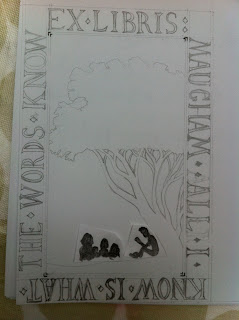I'm preoccupied with "reader experience" at the moment; how we live with and use a book, what our relationship with it is like as an artifact, not just a text.
The text in this case is fantastic, by the way, but this isn't a review. Instead, here goes with my reader experience of Randall:
Black cover, austere, bold type, a tiny splash of colour but no pictures. That all says to me "this is a sharp, clever book". Not exactly inviting, but definitely cool.
An extract from the book on the cover: "People were sobbing and cowering. A man's voice, plummy and shrill, was repeating 'It's just paint! It's just paint!' over and over." You physically can't avoid seeing that several times as you read the book. It influences your expectations. I knew that there was a moment of crisis in the book and that it was of pivotal importance. I was anticipating it until it happened and I had an awareness of its centrality as I was reading it.
The endpapers (and that little splash of colour on the cover) aren't randomly selected. The book is about an artist who at one point invents his own colour - Randall Yellow - and uses it as a personal brand. From that point onwards, the endpapers are promoted from just a nice design touch to being an integral and witty part of the book.
The author biog is another feature you naturally look at a lot when reading this book. It's on the back flap so you naturally use it as a bookmark (at least I did). It's pretty sparse. Literary authors often have this minimal sort of bio. Seems a shame, if you ask me.
In place of a conventional author photo we have an abstract (yellow) paint splash. God knows what it signifies*. Our visual acquaintanceship with the author is deliberately denied. That pissed me off a bit too. Perhaps it should be irrelevant, but I always want to know what the author looks like. In this case perhaps it was decided that it would be a distraction or something.
Overall, though, the fact that this distinctive and clever book was published in a distinctive and clever way definitely strengthened my attachment to it as I was reading it - I was fascinated by the thing as well as the words - and made me want to champion it widely. Which I have.
Reader experience in action.
*postscript: I have just had it explained to me what it signifies and I now feel verrrrry dense not to have clocked it.




















